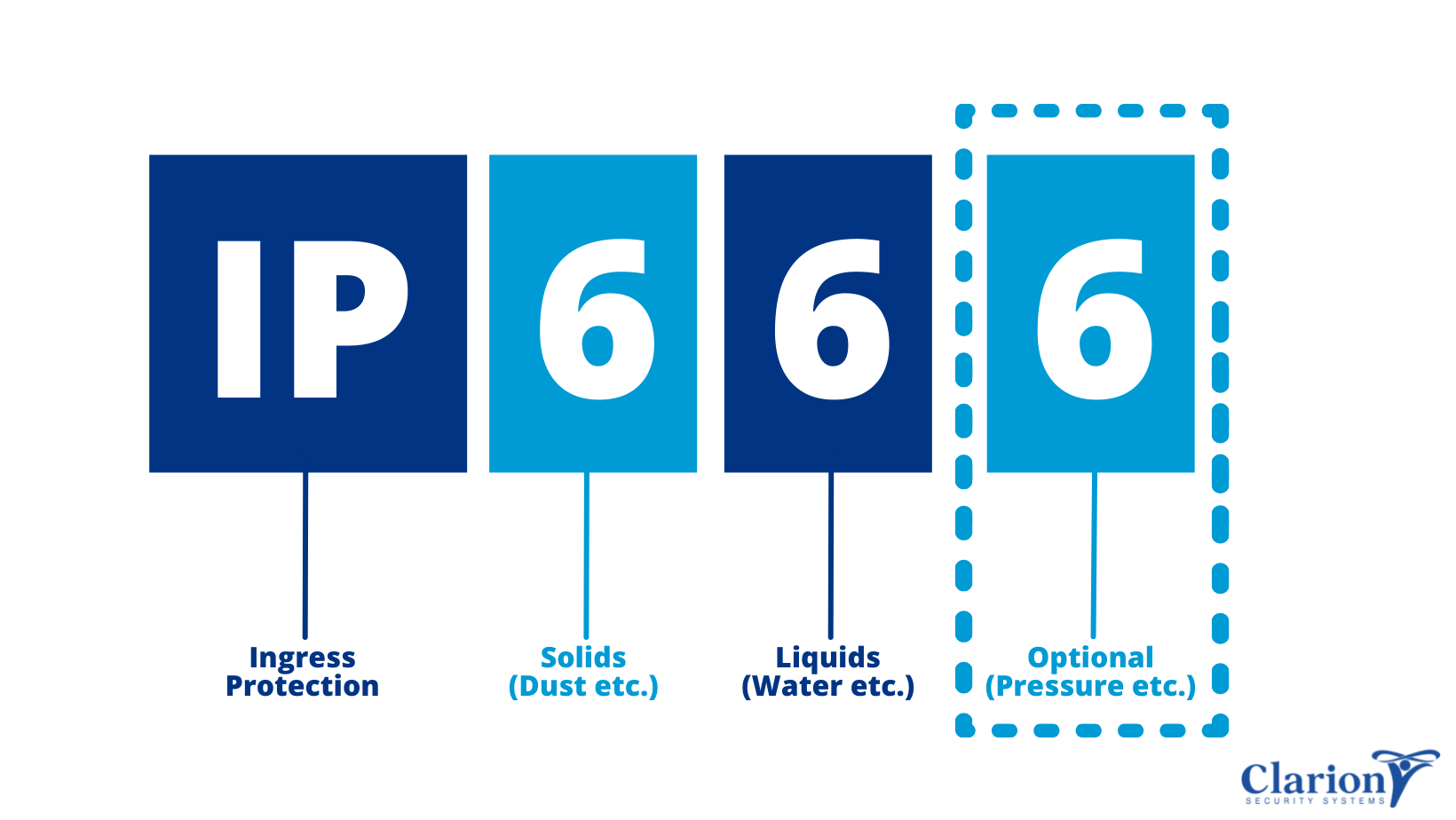What is an IP Rating?
An IP Rating (also known as an Ingress Protection Rating or International Protection Rating) is a way of showing the effectiveness of electrical enclosures in blocking foreign bodies such as dust, moisture, liquids, and accidental contact (2022).
Ingress Protection (IP) ratings measure how resistant a device is against solids and water. IP ratings are determined by the international standard EN 60529 (British BS EN 60529:1992 – Degrees of protection provided by enclosures (IP Code) and European IEC 60509: 1989 – Degrees of protection provided by enclosures (IP Code).
IP Rating Explanation Video
What do the two digits in an IP Rating mean?
IP ratings consist of the letters IP (Ingress Protection), which are then followed by two digits. The higher the number after IP, the better the protection against foreign bodies. Sometimes a number is replaced by an X, this indicates that the enclosure is not yet rated for that specification. So IPX6 for example, means water projected in powerful jets against the enclosure from any direction shall have no harmful effects, while IP6X would denote no ingress of dust; complete protection against contact (dust-tight). There are also several other letters that can be used after the IP rating which signifies other protection levels.
IP65 = First Digit – Solids
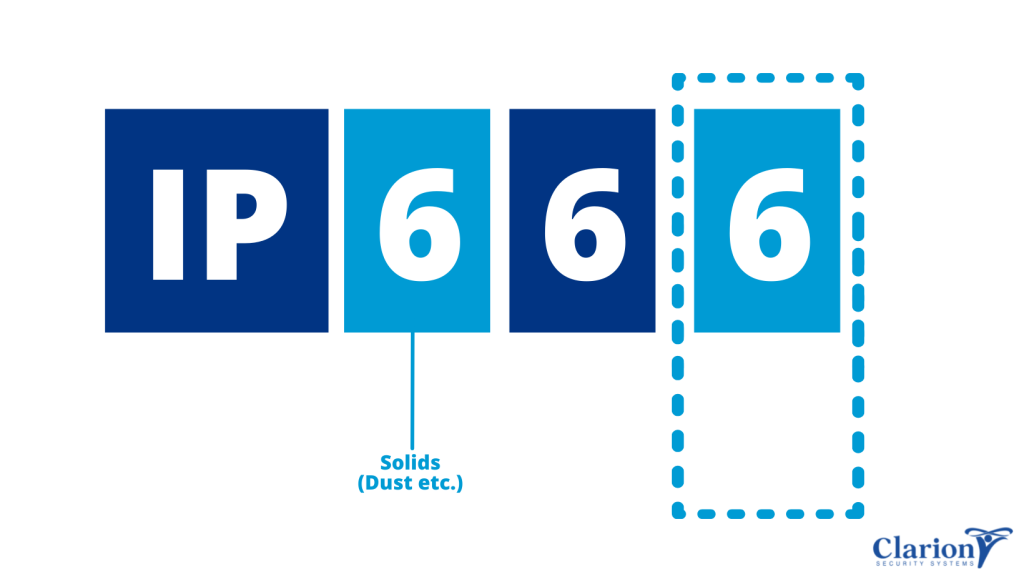
The first digit of the IP rating indicates the level of the enclosure’s protection against the ingress from blocking solid foreign bodies such as dust, tools or fingers that could be hazardous if were to come into contact with electrical components, parts or circuitry within the enclosure.
| Level sized | Effective against | Description |
|---|---|---|
| X | — | X means there is no data available to specify a protection rating with regard to this criterion. |
| 0 | — | No protection against contact and ingress of objects |
| 1 | > 50 mm 2.0 in | Any large surface of the body, such as the back of a hand, but no protection against deliberate contact with a body part |
| 2 | > 12.5 mm 0.49 in | Fingers or similar objects |
| 3 | > 2.5 mm 0.098 in | Tools, thick wires, etc. |
| 4 | > 1 mm 0.039 in | Most wires, slender screws, large ants etc. |
| 5 | Dust protected | Ingress of dust is not entirely prevented, but it must not enter in sufficient quantity to interfere with the satisfactory operation of the equipment. |
| 6 | Dust-tight | No ingress of dust; complete protection against contact (dust-tight). A vacuum must be applied. Test duration of up to 8 hours based on airflow. |
IP65 = Second Digit – Liquids

The second digit of the IP rating indicates the level of the enclosure’s protection from blocking internal components against various forms of moisture (sprays, drips or submersion etc).
| Level | Protection against | Effective against | Details |
|---|---|---|---|
| X | — | — | X means there is no data available to specify a protection rating with regard to these criteria. |
| 0 | None | — | No protection against ingress of water |
| 1 | Dripping water | Dripping water (vertically falling drops) shall have no harmful effect on the specimen when mounted in an upright position onto a turntable and rotated at 1 RPM. | Test duration: 10 minutes. Water equivalent to 1 mm (0.039 in) rainfall per minute |
| 2 | Dripping water when tilted at 15° | Vertically dripping water shall have no harmful effect when the enclosure is tilted at an angle of 15° from its normal position. A total of four positions are tested within two axes. | Test duration: 2.5 minutes for every direction of tilt (10 minutes total) Water equivalent to 3 mm (0.12 in) rainfall per minute |
| 3 | Spraying water | Water falling as a spray at any angle up to 60° from the vertical shall have no harmful effect, utilizing either: a) an oscillating fixture or b) A spray nozzle with a counterbalanced shield. Test a) is conducted for 5 minutes, then repeated with the specimen rotated horizontally by 90° for the second 5-minute test. Test b) is conducted (with a shield in place) for 5 minutes minimum. | For a spray nozzle: Test duration: 1 minute per square meter for at least 5 minutes[5] Water volume: 10 litres per minute (0.037 impgal/s) Pressure: 50–150 kPa (7.3–21.8 psi)For an oscillating tube: Test duration: 10 minutes Water volume: 0.07 litres per minute (0.00026 impgal/s) per hole |
| 4 | Splashing of water | Water splashing against the enclosure from any direction shall have no harmful effect, utilizing either: a) an oscillating fixture or b) A spray nozzle with no shield. Test a) is conducted for 10 minutes. b) is conducted (without shield) for 5 minutes minimum. | Oscillating tube: Test duration: 10 minutes, or spray nozzle (same as IPX3 spray nozzle with the shield removed) |
| 5 | Water jets | Water projected by a nozzle (6.3 mm (0.25 in) against enclosure from any direction shall have no harmful effects. | Test duration: 1 minute per square meter for at least 3 minutes. Water volume: 12.5 litres per minute Pressure: 30 kPa (4.4 psi) at a distance of 3 meters (9.8 ft) |
| 6 | Powerful water jets | Water projected in powerful jets (12.5 mm (0.49 in)) against the enclosure from any direction shall have no harmful effects. | Test duration: 1 minute per square meter for at least 3 minutes. Water volume: 100 litres per minute (0.37 impgal/s) Pressure: 100 kPa (15 psi) at a distance of 3 meters (9.8 ft) |
| 6K | Powerful water jets with increased pressure | Water projected in powerful jets (6.3 mm (0.25 in) nozzle) against the enclosure from any direction, under elevated pressure, shall have no harmful effects. Found in DIN 40050, and not IEC 60529. | Test duration: at least 3 minutes Water volume: 75 liters per minute (0.27 impgal/s) Pressure: 1,000 kPa (150 psi) at distance of 3 meters (9.8 ft) |
| 7 | Immersion, up to 1 meter (3 ft 3 in) depth | Ingress of water in harmful quantity shall not be possible when the enclosure is immersed in water under defined conditions of pressure and time (up to 1 meter (3 ft 3 in) of submersion). | Test duration: 30 minutes. Tested with the lowest point of the enclosure 1,000 mm (39 in) below the surface of the water, or the highest point 150 mm (5.9 in) below the surface, whichever is deeper. |
| 8 | Immersion, 1 meter (3 ft 3 in) or more depth | The equipment is suitable for continuous immersion in water under conditions that shall be specified by the manufacturer. However, with certain types of equipment, it can mean that water can enter but only in such a manner that it produces no harmful effects. The test depth and duration is expected to be greater than the requirements for IPx7, and other environmental effects may be added, such as temperature cycling before immersion. | Test duration: Agreement with manufacturer depth specified by the manufacturer, generally up to 3 meters (9.8 ft) |
| 9K | Powerful high-temperature water jets | Protected against close-range high pressure, high-temperature spray downs. Smaller specimens rotate slowly on a turntable, from 4 specific angles. Larger specimens are mounted in the intended position when being used, no turntable required, and are tested freehand for at least 3 minutes at a distance of 0.15–0.2 meters (5.9 in–7.9 in). The specific requirements for the test nozzle are shown in figures 7, 8, & 9 of IEC (or EN) 60529. This test is identified as IPx9 in IEC 60529. | Test duration: Fixture: 30 sec. in each of 4 angles (2 min. total), Freehand: 1 min/m2, 3 min. minimum water volume: 14–16 litres per minute (0.051–0.059 impgal/s) Pressure: 8–10 MPa (80–100 bar) at a distance of 0.10–0.15 meters (3.9 in–5.9 in) Water temperature: 80 °C (176 °F) |
IP65? = Third Digit – Supplementary Information
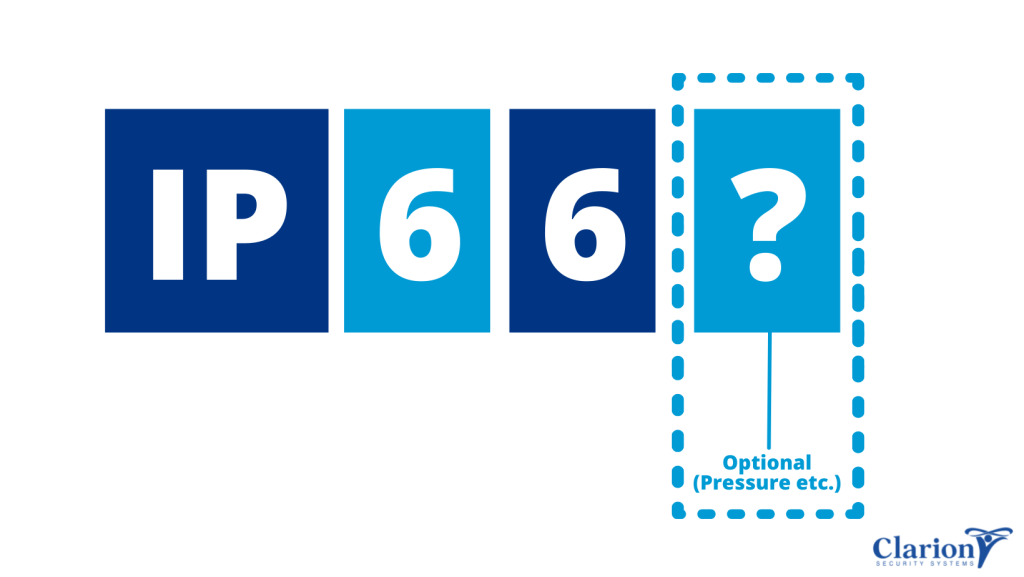
Sometimes on IP Ratings, there might be a letter at the end of the code IPXX. This is the supplementary letter and it is used to denote supplementary information from the product standard.
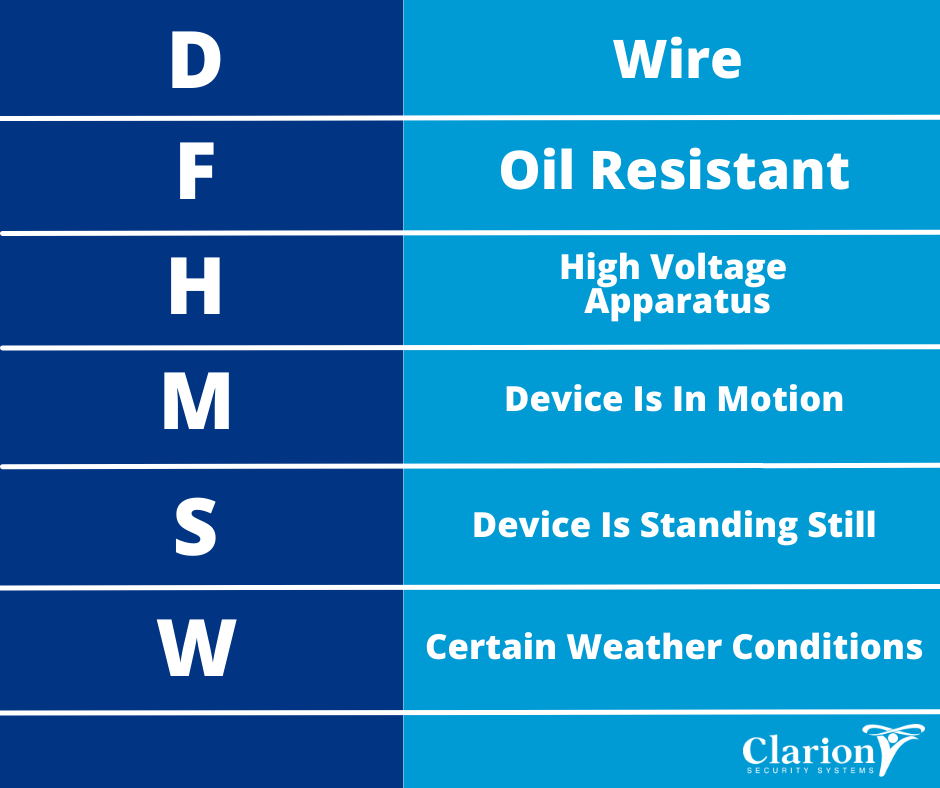
What is the difference between IP55 and IPW55 protection? IP55W vs IP55
The “W” in IP55W states that the IP rating meets certain weather conditions. e.g. condensation, rain and humidity.
IP55 = Limited protection from dust and low-pressure water jets from any direction.
IP55W = Limited protection from dust, low-pressure water jets from any direction and against damp and wet weather.
What is the difference between IP23 and IP23S, and which has more stringent testing criteria?
‘S’ means ‘Device standing still’. IP23 is considered more stringent than IP23S as it covers this and IP23M (which means ‘Device is in motion during water test’).
What does the D mean in IP23D
‘D’ means protection against a wire touching hazardous parts.
What does the B mean in IP43B
The “B” means protection against access to hazardous parts with a finger.
IP rating for outdoor use
IP ratings of between 44 and 65 may be used for both indoor and general outdoor use. Anything lower than IP44 should only be used indoors, however.
IP Rating Charts
| First digit | Mechanical Protection | Second digit | Water ingress protection |
|---|---|---|---|
| 0 | No protection | 0 | No protection |
| 1 | Protected against solid objects over 50mm, e.g. accidental touch by hands | 1 | Protected against vertically falling drops of water e.g. condensation |
| 2 | Protected against solid objects over 12mm, e.g. fingers | 2 | Protected against direct sprays of water up to 15 ° from the vertical |
| 3 | Protected against solid objects over 2.5mm, e.g. tools & wires | 3 | Protected against direct sprays of water up to 60 ° from the vertical |
| 4 | Protected against solid objects over 1mm, e.g. wires, nails etc. | 4 | Protected against water splashed from all directions, limited ingress permitted |
| 5 | Protected against dust limited ingress, not harmful deposits | 5 | Protected against low-pressure jets of water from all directions, limited ingress permitted |
| 6 | Totally protected against dust | 6 | Protected against strong jets of water e.g. on the deck of the ship, limited ingress permitted |
| n/a | n/a | 7 | Protected against the effects of temporary immersion between 15cm and 1m. Duration of test 30 minutes |
| n/a | n/a | 8 | Protected against long periods of immersion under pressure |
IP Ratings Chart
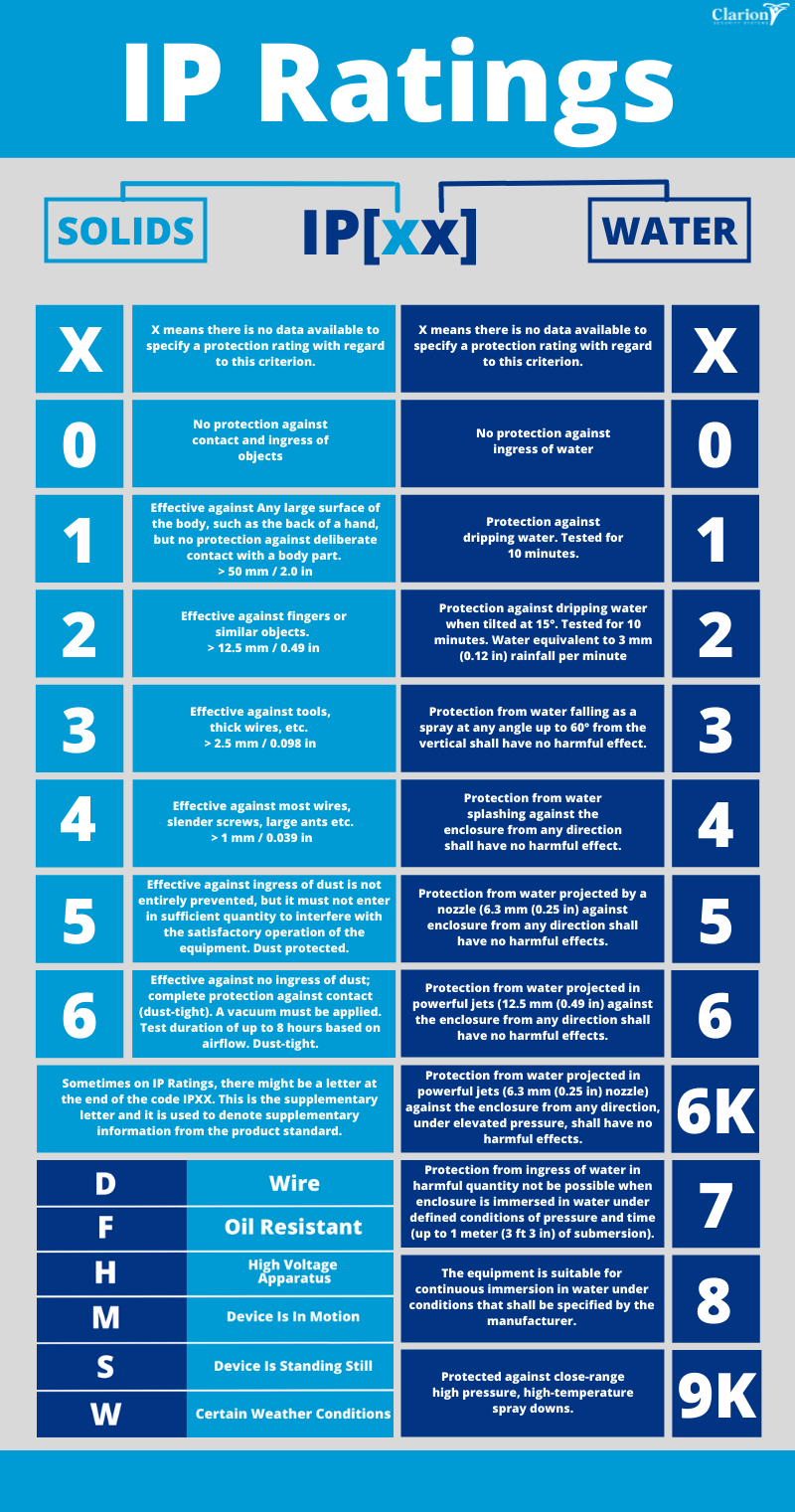
IP Rating Reference Chart
| IP Rating | First Digit – SOLIDS | Second Digit – LIQUIDS |
|---|---|---|
| What is IP00 rating? | Not protected | Not protected from liquids |
| What is IP01 rating? | Not protected | Protected from condensation |
| What is IP02 rating? | Not protected | Protected from water spray less than 15 degrees from vertical |
| What is IP03 rating? | Not protected | Protected from water spray less than 60 degrees from vertical |
| What is IP04 rating? | Not protected | Protected from water spray from any direction |
| What is IP05 rating? | Not protected | Protected from low-pressure water jets from any direction |
| What is IP06 rating? | Not protected | Protected from high-pressure water jets from any direction |
| What is IP07 rating? | Not protected | Protected from immersion between 15 centimetres and 1 metre in depth |
| What is IP08 rating? | Not protected | Protected from long term immersion up to a specified pressure |
| What is IP10 rating? | Protected from touch by hands greater than 50 millimetres | Not protected |
| What is IP11 rating? | Protected from touch by hands greater than 50 millimetres | Protected from condensation |
| What is IP12 rating? | Protected from touch by hands greater than 50 millimetres | Protected from water spray less than 15 degrees from vertical |
| What is IP13 rating? | Protected from touch by hands greater than 50 millimetres | Protected from water spray less than 60 degrees from vertical |
| What is IP14 rating? | Protected from touch by hands greater than 50 millimetres | Protected from water spray from any direction |
| What is IP15 rating? | Protected from touch by hands greater than 50 millimetres | Protected from low-pressure water jets from any direction |
| What is IP16 rating? | Protected from touch by hands greater than 50 millimetres | Protected from high-pressure water jets from any direction |
| What is IP17 rating? | Protected from touch by hands greater than 50 millimetres | Protected from immersion between 15 centimetres and 1 metre in depth |
| What is IP18 rating? | Protected from touch by hands greater than 50 millimetres | Protected from long term immersion up to a specified pressure |
| What is IP20 rating? | Protected from touch by fingers and objects greater than 12 millimetres | Not protected |
| What is IP21 rating? | Protected from touch by fingers and objects greater than 12 millimetres | Protected from condensation |
| What is IP22 rating? | Protected from touch by fingers and objects greater than 12 millimetres | Protected from water spray less than 15 degrees from vertical |
| What is IP23 rating? | Protected from touch by fingers and objects greater than 12 millimetres | Protected from water spray less than 60 degrees from vertical |
| What is IP24 rating? | Protected from touch by fingers and objects greater than 12 millimetres | Protected from water spray from any direction |
| What is IP25 rating? | Protected from touch by fingers and objects greater than 12 millimetres | Protected from low-pressure water jets from any direction |
| What is IP26 rating? | Protected from touch by fingers and objects greater than 12 millimetres | Protected from high-pressure water jets from any direction |
| What is IP27 rating? | Protected from touch by fingers and objects greater than 12 millimetres | Protected from immersion between 15 centimetres and 1 metre in depth |
| What is IP28 rating? | Protected from touch by fingers and objects greater than 12 millimetres | Protected from long term immersion up to a specified pressure |
| What is IP30 rating? | Protected from tools and wires greater than 2.5 millimetres | Not protected |
| What is IP31 rating? | Protected from tools and wires greater than 2.5 millimetres | Protected from condensation |
| What is IP32 rating? | Protected from tools and wires greater than 2.5 millimetres | Protected from water spray less than 15 degrees from vertical |
| What is IP33 rating? | Protected from tools and wires greater than 2.5 millimetres | Protected from water spray less than 60 degrees from vertical |
| What is IP34 rating? | Protected from tools and wires greater than 2.5 millimetres | Protected from water spray from any direction |
| What is IP35 rating? | Protected from tools and wires greater than 2.5 millimetres | Protected from low-pressure water jets from any direction |
| What is IP36 rating? | Protected from tools and wires greater than 2.5 millimetres | Protected from high-pressure water jets from any direction |
| What is IP37 rating? | Protected from tools and wires greater than 2.5 millimetres | Protected from immersion between 15 centimetres and 1 metre in depth |
| What is IP38 rating? | Protected from tools and wires greater than 2.5 millimetres | Protected from long term immersion up to a specified pressure |
| What is IP40 rating? | Protected from tools and small wires greater than 1 millimetre | Not protected |
| What is IP41 rating? | Protected from tools and small wires greater than 1 millimetre | Protected from condensation |
| What is IP42 rating? | Protected from tools and small wires greater than 1 millimetre | Protected from water spray less than 15 degrees from vertical |
| What is IP43 rating? | Protected from tools and small wires greater than 1 millimetre | Protected from water spray less than 60 degrees from vertical |
| What is IP44 rating? | Protected from tools and small wires greater than 1 millimetre | Protected from water spray from any direction |
| What is IP45 rating? | Protected from tools and small wires greater than 1 millimetre | Protected from low-pressure water jets in any direction |
| What is IP46 rating? | Protected from tools and small wires greater than 1 millimetre | Protected from high-pressure water jets from any direction |
| What is IP47 rating? | Protected from tools and small wires greater than 1 millimetre | Protected from immersion between 15 centimetres and 1 metre in depth |
| What is IP48 rating? | Protected from tools and small wires greater than 1 millimetre | Protected from long term immersion up to a specified pressure |
| What is IP50 rating? | Protected from limited dust ingress | Not protected |
| What is IP51 rating? | Protected from limited dust ingress | Protected from condensation |
| What is IP52 rating? | Protected from limited dust ingress | Protected from water spray less than 15 degrees from vertical |
| What is IP53 rating? | Protected from limited dust ingress | Protected from water spray less than 60 degrees from vertical |
| What is IP54 rating? | Protected from limited dust ingress | Protected from water spray from any direction |
| What is IP55 rating? | Protected from limited dust ingress | Protected from low-pressure water jets from any direction |
| What is IP56 rating? | Protected from limited dust ingress | Protected from high-pressure water jets from any direction |
| What is IP57 rating? | Protected from limited dust ingress | Protected from immersion between 15 centimetres and 1 metre in depth |
| What is IP58 rating? | Protected from limited dust ingress | Protected from long term immersion up to a specified pressure |
| What is IP60 rating? | Protected from total dust ingress | Not protected |
| What is IP61 rating? | Protected from total dust ingress | Protected from condensation |
| What is IP62 rating? | Protected from total dust ingress | Protected from water spray less than 15 degrees from vertical |
| What is IP63 rating? | Protected from total dust ingress | Protected from water spray less than 60 degrees from vertical |
| What is IP64 rating? | Protected from total dust ingress | Protected from water spray from any direction |
| What is IP65 rating? | Protected from total dust ingress | Protected from low-pressure water jets from any direction |
| What is IP66 rating? | Protected from total dust ingress | Protected from high-pressure water jets from any direction |
| What is IP67 rating? | Protected from total dust ingress | Protected from immersion between 15 centimetres and 1 metre in depth |
| What is IP68 rating? | Protected from total dust ingress | Protected from long term immersion up to a specified pressure |
| What is IP69K rating? | Protected from total dust ingress | Protected from steam-jet cleaning |
Weatherproof & waterproof IP ratings
A ‘waterproof’ or ‘weatherproof’ IP rating is often used when looking at everyday products such as mobile phones, bathroom fixtures and CCTV enclosures etc.
For example, all iPhone 13 models (iPhone 13, iPhone 13 mini, iPhone 13 Pro, and iPhone 13 Pro Max) have an IP rating of IP68.
Which IP rating is waterproof?
IP ratings of IP65, 66 and 67 are considered waterproof. The term “waterproof“ is only applicable under certain conditions.
IP65 Rating Meaning
IP65 rating means that the enclosure can only provide protection against low pressure (6.3mm) water jets.
- Protected from total dust ingress
- Protected from low-pressure water jets from any direction
IP65 Rating products offer reliable protection and are used for many indoor and outdoor applications.
IP66 Rating Meaning
IP66 rated enclosure provides protection against high pressure (12.5mm) water jets. The test includes the enclosure being subjected to 100 litres per minute of water volume with the pressure of 100 kPa at a distance of 3m for at least 3 minutes.
- Protected from total dust ingress
- Protected from high-pressure water jets from any direction
IP66 ratings are the highest level of waterproof protection. An IP68 rating is a next step up if you need the product to survive total submersion in water.
IP65 Rating vs. IP66 Rating
Understanding the level of protection you need depends on what you need the enclosure to withstand.
Both IP65 and IP66 ratings provide protection against solid ingress from debris, first and dust. The main difference between IP65 and IP66 ratings is their level of protection against liquid ingress. An IP66 rated enclosure can handle a higher level of pressurised water spray compared with an IP65 rated enclosure.
So when looking at your requirements you need to choose between IP65 and IP66 based on whether the device will encounter pressurised water. If it does then an IP66 enclosure is the correct choice. However, if your device is unlikely to face any pressurised water then an IP65 rated enclosure will suffice.
IP67 Rating Meaning
IP67 rating means that the enclosure provides protection against immersion up to 1m. The test includes immersion at a depth of at least 1m for 30 minutes or more.
IP65 Rating vs. IP67 Rating
Both IP65 and IP67 ratings provide excellent protection and are well suited for outdoor applications. There are a few distinctions that may make a difference for your intended final usage.
Both IP65 and IP67 ratings offer total protection from solids ingress. The major difference is the degree of liquid ingress protection that they offer.
- An IP65 rated enclosure provides ptotection from low-pressure water jets from any direction. This is suitable for most outdoor enclosures that will not encounter any extreme weather such as water submersion.
- An IP67 rated enclosure however offers more protection agionast liquid ingress. An IP67 rated enclosure will protect agnist temporary submersion at depths of up to one metre.
Neither of the above IP ratings will protect against prolonged submersion at depths of over one metre. If you think your enclosure will be submerged for an extended period of time then you will need an IP rating of at least IP68 to protect against these conditions.
Is IP68 Rating Meaning – Is It fully submersible?
IP68 provides protection from immersion depths of at least 1 meter. It is sometimes considered as total protection against solids and moisture. However, this can be vague and the manufacturer and user must agree on the specification for IP68, against their requirements and application.
IP67 Rating vs. IP68 Rating
There is a distinct difference between being waterproof and water-resistant.
Waterproof – It is impervious to water regardless of long it is submerged.
Water resist – A product can stop water from entering it to some degree, but not entirely. Most products like smartphones are water-resistant and can not survive in water indefinitely, always consult the manufacturer’s information for more information.
Both IP67 and IP68 Ratings offer the below similarities:
- Protected from total dust ingress
- Protected from immersion between 15 centimetres and 1 metre in depth
IP67 Rating vs. IP68 Rating Differences
The differences between IP67 Rating vs. IP68 Rating enclosures are:
- An IP67 enclosure is rated to be protected from immersion, but only at a depth of 1 meter and for 30 minutes.
- An IP68 enclosure is rated to be protected from immersion of at least 1 meter and up to 30 minutes (This could also be extended if specified by the manufacturer).
What is IP69K?
IP69K is the highest protection IP rating. It provides complete protection against the ingress of both dust and water jets directed at the enclosure using both a high temperature and pressure. It is mostly used in heavy washdown environments such as food and beverage processing industries.
Clarion Security Systems
Clarion offer a range of commercial security systems, business CCTV systems, access control systems and commercial intruder alarms for clients in Manchester, the North West and across the UK. For more information on our services, please contact us today to discuss your needs.
